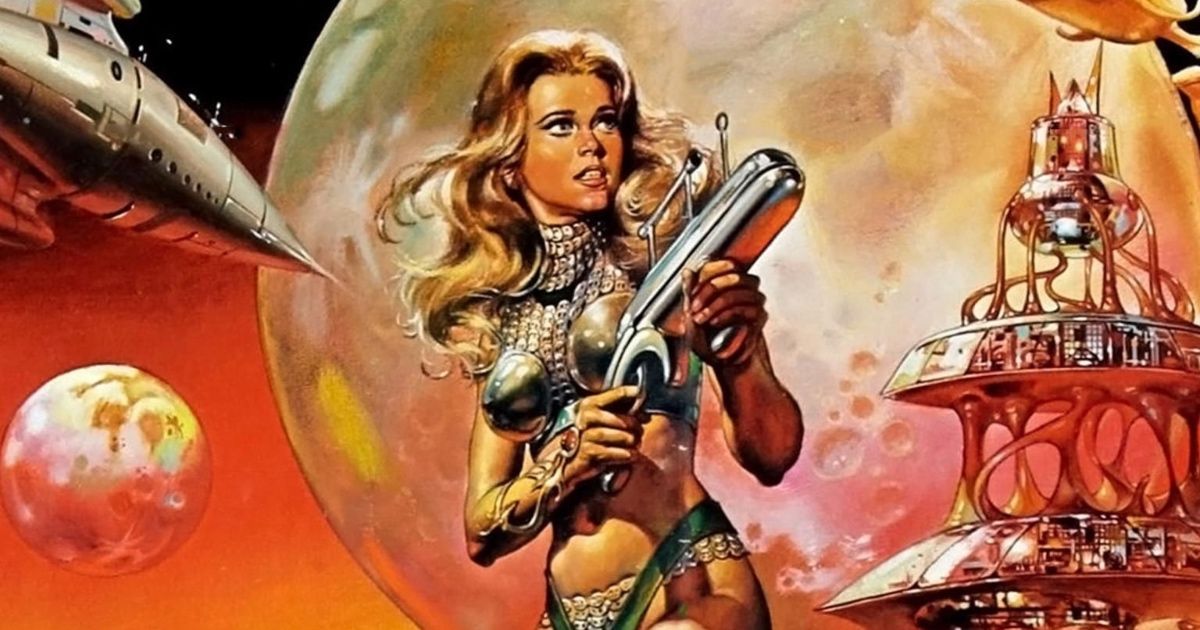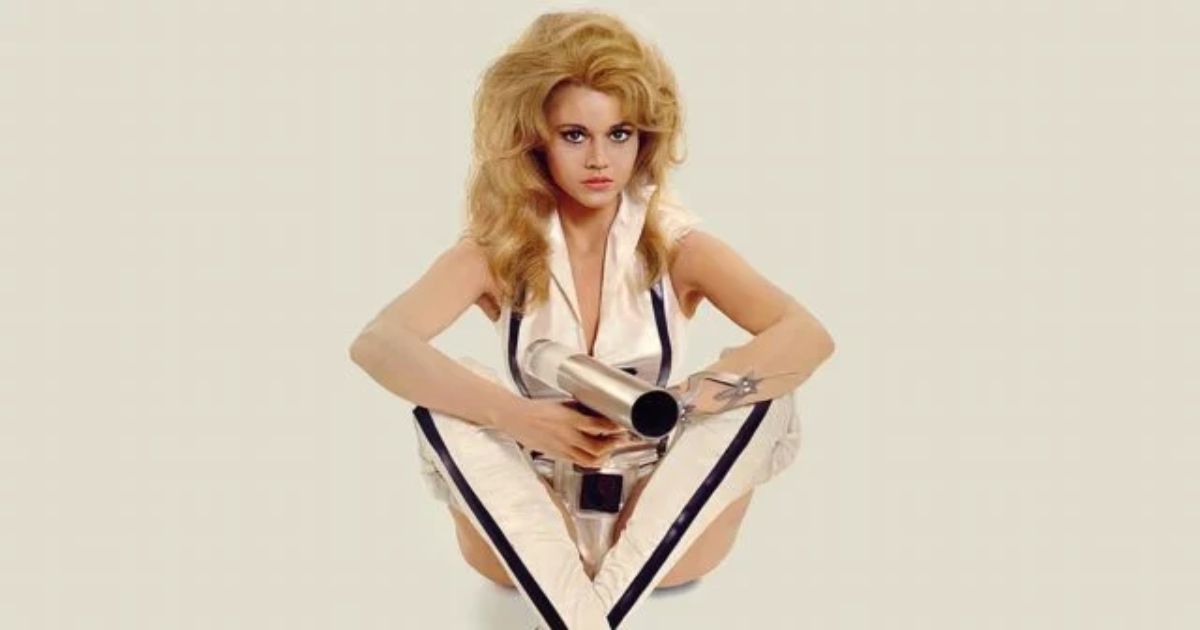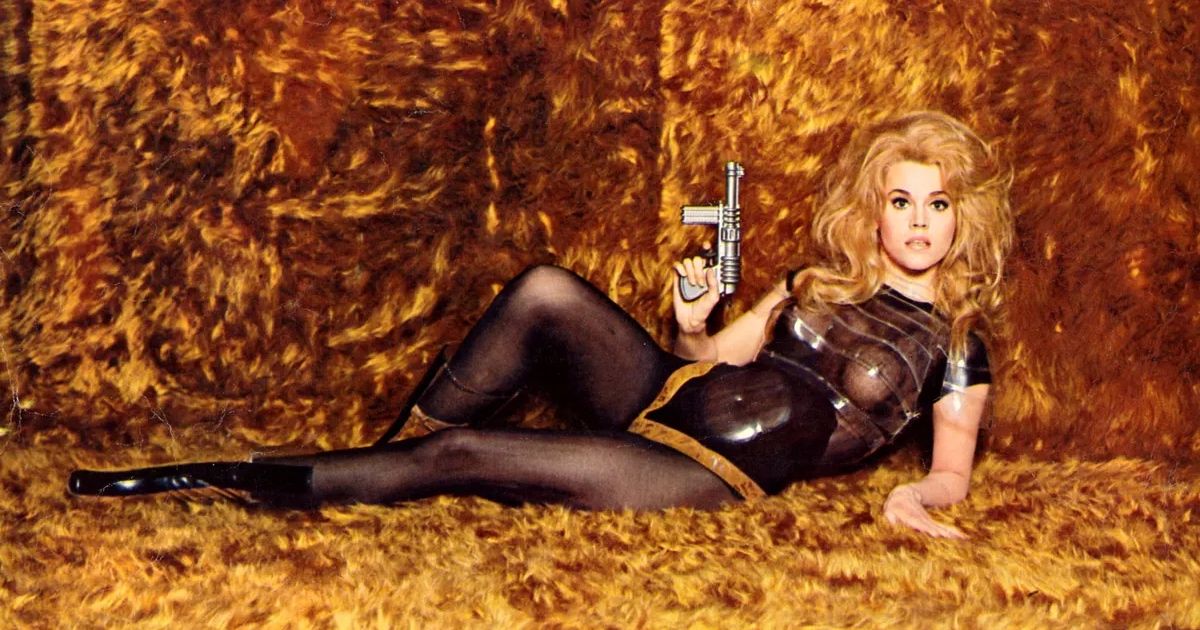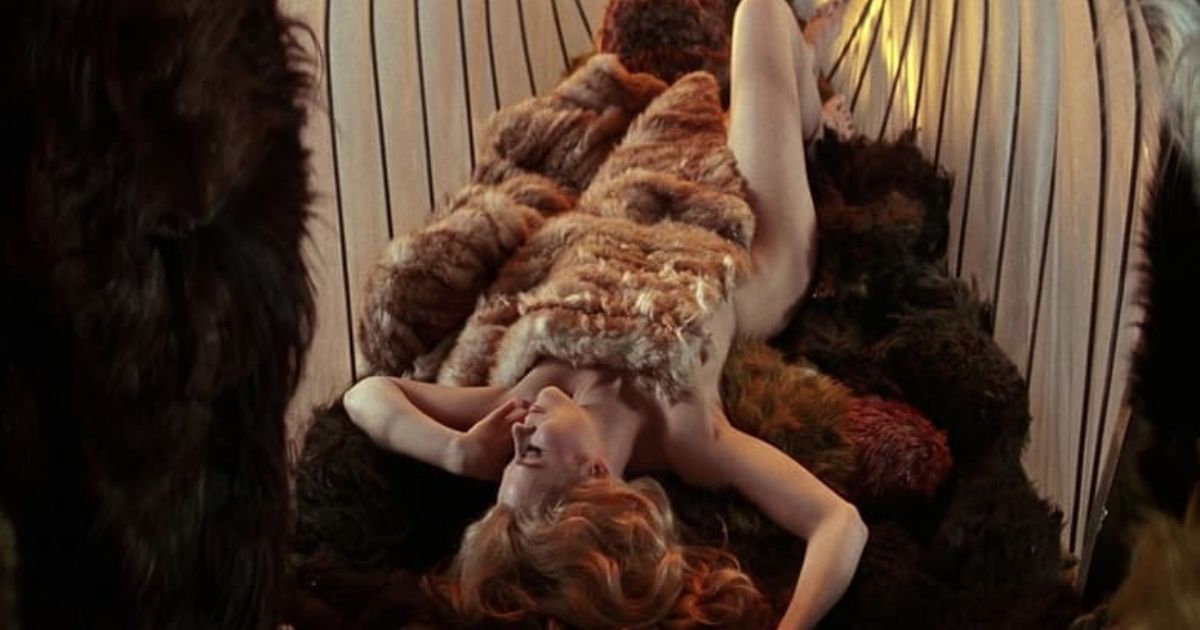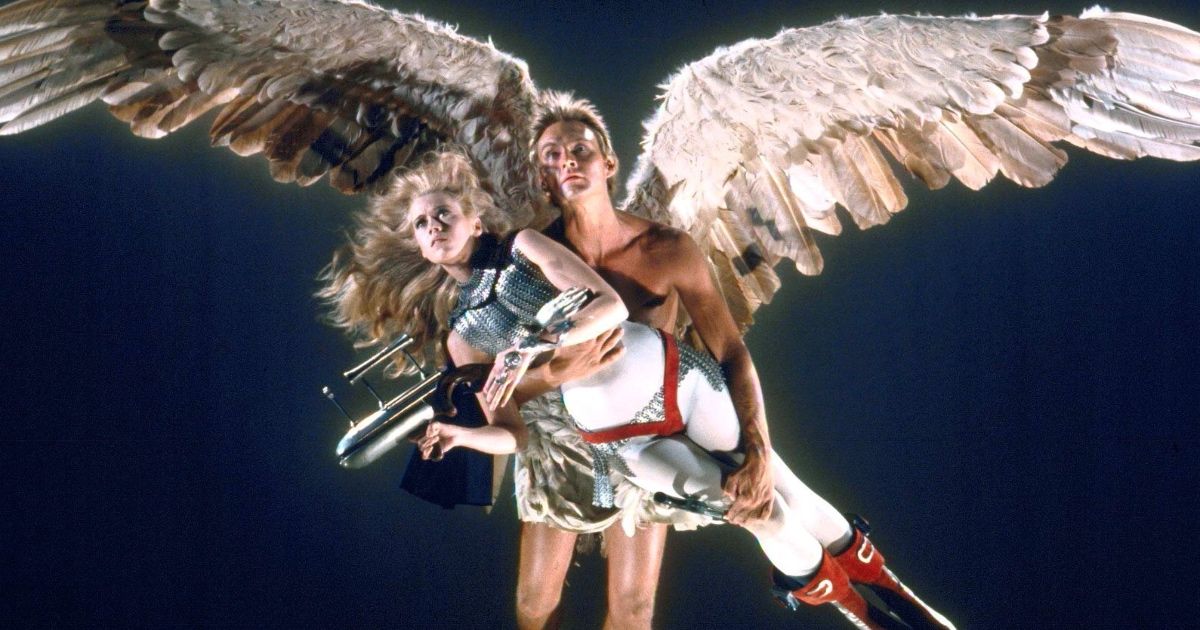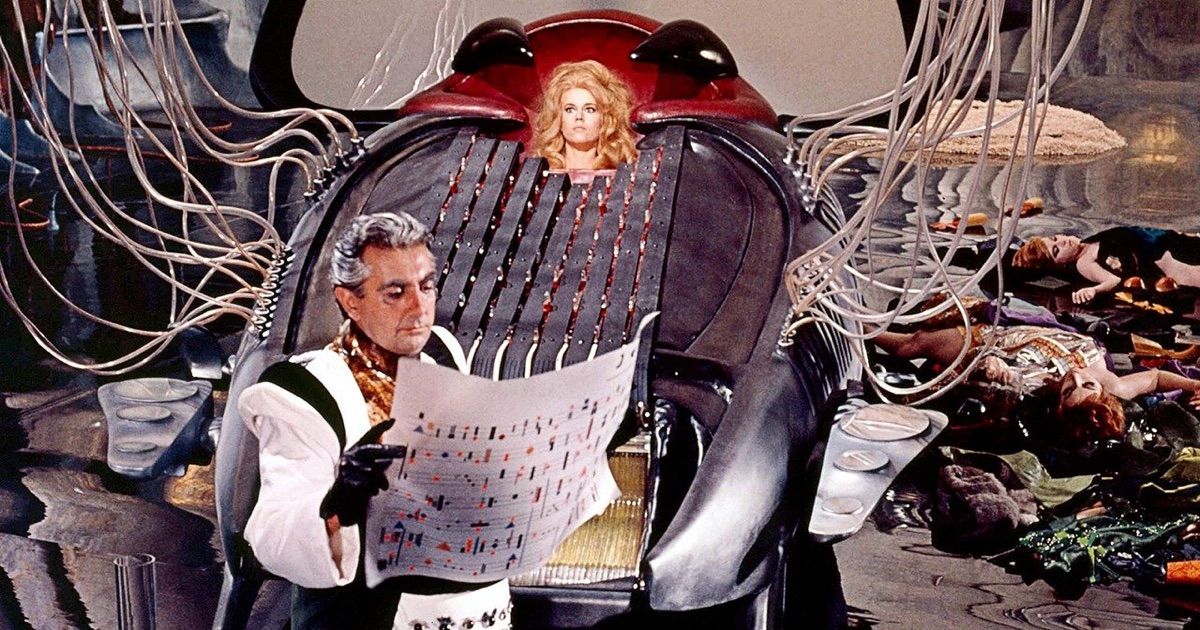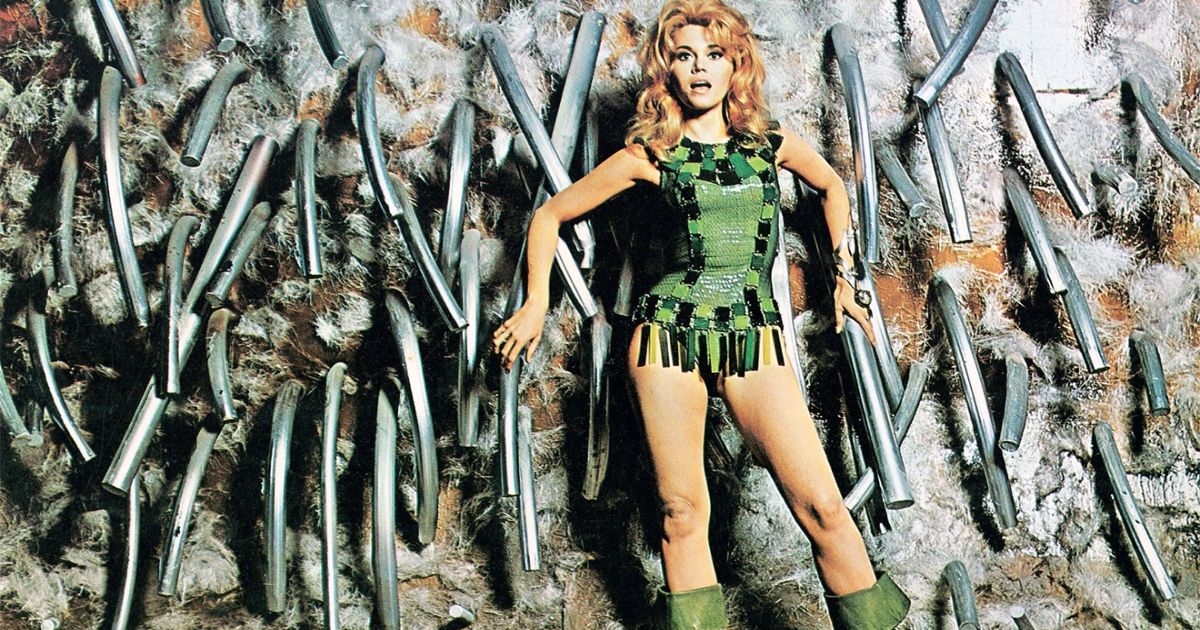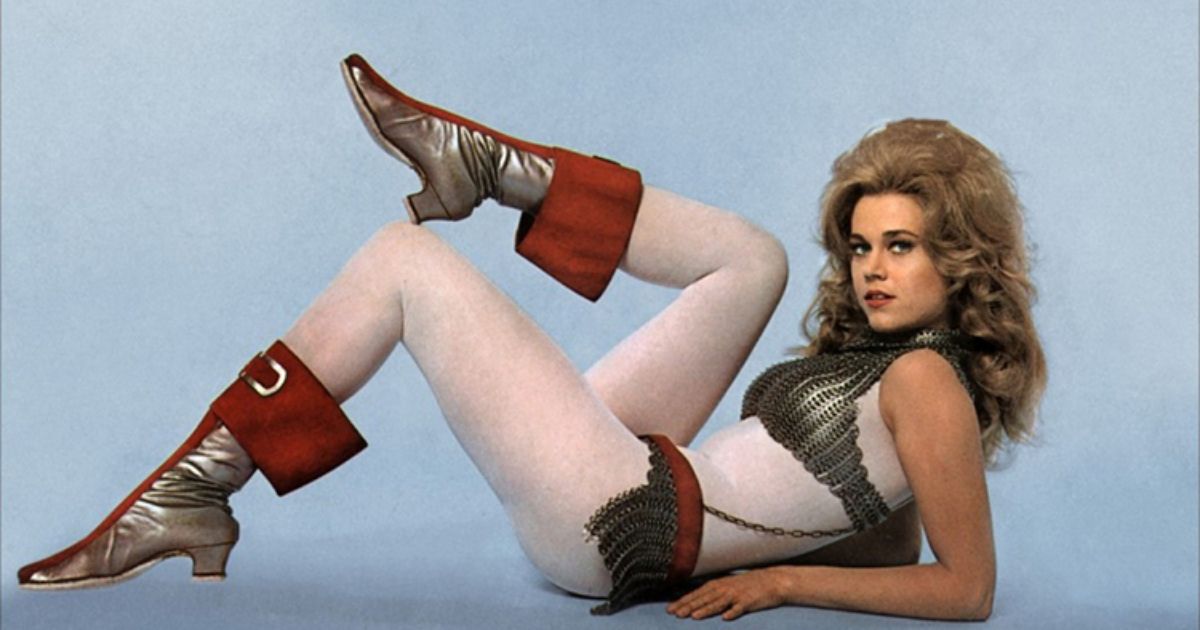XLI century. A mad scientist named Durand Durand (inspiring a certain British band to name themselves after him) creates a weapon of mass destruction. Only the interstellar envoy of the United Earth and their beautiful representative Barbarella, can save the planet and the entire Universe. She sets out on her travels through the Galaxy on a plush psychedelic ship. Along the way, the heroine meets many amazing space creatures and saves the world with love — in every sense of the word. Barbarella exists in a post-surrealist rococo plane, combining Middle Ages and the Renaissance nostalgia with pop art, dreamy eroticism with absurdist humor.
Funnily enough, upon its release in 1968, Barbarella did not actually gain much attention at the domestic box office (in the US or France) — that, however, did not stop her from captivating the hearts of viewers all over the world. The film also surprised its audience with inventive scenery, off-the-wall cinematography, whimsical costumes, and canny self-irony. Barbarella, like a lot of effective irony, is so canny that it became difficult to catch the difference between satire and literality, especially with the back-and-forth feminist discourse. The perception of Barbarella has ranged from deriding it as a problematic objectification of women to declaring it a staple of female sexual liberation.
So which one is it, and what makes this perky and phantasmagoric film, a product of the era of sexual revolution and grotesque psychedelia alike, so special that it gathered quite the diverse following as a cult classic, which includes the LGBT community, the fashion realm, sci-fi fans, and arthouse buffs?
How Did Barbarella Come To Be?
The sexual revolution in the 60s changed European society quite dramatically, and these changes were reflected in contemporary art. In 1962, Jean-Claude Forest, the French writer and illustrator, created Barbarella, the first sci-fi adult comic book. Dino De Laurentiis, the cinematographer, who had previously worked with Vidor, Fellini, Godard, and Visconti, was looking for interesting material that would help him "depict a new futuristic morality".
De Laurentiis entrusted this cinematic adaptation of a comic book to the director Roger Vadim, known for his films And God Created Woman (which broke sexual taboos and introduced the world to Brigitte Bardot), Dangerous Liaisons, and The Game is Over. Terry Southern, who wrote the first draft of the screenplay (along with Dr. Strangelove and Easy Rider), said about working with him: “Vadim wasn't particularly interested in the script, but he was a lot of fun, with a discerning eye for the erotic, grotesque, and the absurd.”
Vadim came up with the idea to shoot the film exclusively in the pavilion, without any external locations, and to use a lava lamp to create a fashionable “psychedelic picture” of the 1960s in moments of moving at supersonic speeds through space. The sequence with the weightless striptease in zero gravity was filmed by turning the setting upside down and placing the heroine on a glass sheet. Constructing monster dolls, the orgasmatron, and the scenes of air battles took the most time and effort for the filming team.
Jane Fonda as The First Female Lead in Sci-Fi
Nowadays, Barbarella is considered one of the finest performances by Jane Fonda — she was not, however, the first choice for the role of the naive and curious space traveler; moreover, she refused the offer. Brigitte Bardot (the original inspiration for the comic book Barbarella) and Sophia Loren consistently refused to participate in the film because of the gratuitous explicit moments. At first, Jane Fonda had little interest in it too, but her then-husband Vadim (who was Bardot's husband a decade prior) managed to convince her, and she later came to see it as a “kind of tongue in cheek satire against bourgeois morality."
In an interview, Fonda brought up the issue of the male gaze and ‘soft porn’ allegations: “Barbarella is a film that’s always brought up, but as a matter of fact, I was hardly ever nude. Most of the pictures where I was dressed to the teeth and played a cute little ingénue were more exploitative than the ones with nudity because they portrayed women as silly, as mindless, as motivated purely by sex in relation to men…”
Barbarella particularly skyrocketed Fonda’s celebrity status. Jane Fonda became the first female lead in an action or sci-fi film, more than a decade before Sigourney Weaver duked it out with a Xenomorph as Ripley in Alien. The Guardian writes: “Barbarella is Mr Rogers as Jesus Christ as Marilyn Monroe; the sex bomb who will bring about world peace while reassuring you that you'll never go down the drain.”
Fonda’s Barbarella came across as both an innocently charming and daringly laid-back character with powerful sexual energy. Girls Do Film points out that while the male-led ‘space race’ was the focus of people at the time, Barbarella offered an interesting alternative: “a female astronaut who was sexy, single and political – a highly dangerous combination."
It should be pointed out that while voyeuristic, the opening credits' scene shows Barbarella stripping off what is probably one of the coolest-looking space suits not for anyone but herself; she is her own enjoyment. You Must Remember This Podcast also praises Fonda’s acting and how it presents the idea of eager consent: “She’s almost always the most active presence in any given scene… There’s no way you could watch a Jane Fonda performance and not know what her character wanted.”
Barbarella as a High Camp Classic
Apart from its source material, Barbarella also referenced the aesthetics of 1920s and '30s sci-fi like Metropolis and Things to Come, with their slightly silly, grandiose, overly-stylized futurism. For comparison, Stanley Kubrick's A Space Odyssey was released in the same year as Barbarella; in terms of minimalist style and seriousness of approach, it’s the complete opposite of Vadim's movie.
Perhaps it was its frivolous attitude that pushed Barbarella to international recognition as one of the 60s cult classics. With the skill of a recognized tightrope walker, Vadim managed to balance between the banal vulgarity of trivial fantastic crafts and the frankness of erotica.
Barbarella never took itself too seriously and easily produced iconic moments as a result of its playful spirit. Take, for instance, the reference to the parrot scene from Hitchcock's The Birds. Or the appearance of creepy twins way before Kubrick's The Shining. This movie etched its place in pop culture. The black bandage look would inspire Gaultier’s costume design in The Fifth Element. A Maxi Challenge on the Emmy-winning RuPaul’s Drag Race was even dedicated to Barbarella, a tribute to its double entendres and risqué campiness. The aforementioned Duran Duran took their name from Dr. Durand Durand; the influences are seemingly endless.
Vadim also managed to gather a stellar cast of influential figures. The legendary mime Marcel Marceau not only played in the film but also spoke for the first time on the screen. Like most mimes, Marceau preferred to work in silence (even releasing a vinyl record, The Best of Marcel Marceau, which was just 19 minutes of silence followed by applause), but his break in Barbarella provides some silly, surrealist fun.
Anita Pallenberg, the girlfriend of the Rolling Stones (yes, pretty much all of them), starred as Barbarella's evil alter ego, The Great Tyrant. Pallenberg played a BDSM bee hive queen with a mystique that matches her real-life image quite well. Dildano was first portrayed by an Italian actor, who did not understand the humor of his scenes and played deadly serious, so Vadim invited David Hemmings (a legend in art cinema for Blow-Up) to give the character justice.
The Fashion Legacy of a Psychedelic Space Romp
Contrary to a popular belief, Paco Rabanne had almost nothing to do with Barbarella‘s great fashion design, apart from the final outfit, a green leotard decorated with rhodoid plates. The plated trim is no doubt a reference to Rabanne's "unwearable" dresses from the 1966 collection. The bright green also didn’t fit in with the more subdued color scheme.
The need for another costume for Fonda arose when the contract with Jacques Fonteray, the actual costume designer for the movie, had expired. Vadim gave Fonteray complete freedom. It was necessary to come up with an overall futuristic aesthetic with unusual shapes and materials, and they quickly agreed on the use of plastic, which allowed them to play with volumes, colors, and transparency.
For Barbarella’s black leotards with see-through plastic armor, a custom cast of Fonda’s breasts was made. Her metal mini chainmail with a short cloak is Renaissance-inspired. The bodysuit with one “bare” breast refers to the Amazons, and the cape with polka dots is a pop art piece. In total, Barbarella changes costume about 20 glorious times throughout the film. The designs reflected the fashion trends of the mid-1960s, from radical mini in combination with go-go boots to lush hairstyles.
Jean-Paul Gaultier admitted that he designed the costumes for The Fifth Element under the strong influence of Barbarella, and even dedicated his fall-winter 2009 couture show to it. In 1997, the Givenchy brand referenced the famous half-naked angel in its couture collection. Homages to the film can also be found in the Dior fall-winter 2014 collection, as well as in the collections of Jeremy Scott (spring-summer 2016) and Rodarte (autumn-winter 2008). Kate Moss appeared as Barbarella in a Whitaker Malem leather corset in the December 1991 Elle. Doutzen Kroes, in turn, starred as the iconic space voyager for Vogue Netherland in 2015.
As if created on the principle of “show more than hide,” Barbarella’s costumes spoke for her — for once a woman can choose what to do, and not be ashamed of this choice at all. The result is a sexy, not sexist, film that practically turns the phrase "the future is female" into a literal truism.

